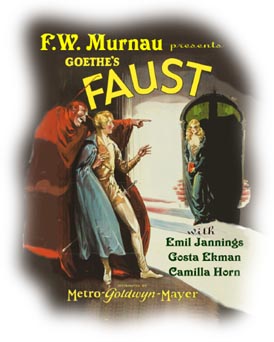

"Faust" was the culmination of the fantasy element in German cinema, the final triumph of pictorial beauty and design, whose famous forerunners were "Caligari," "Destiny," "Siegfried," "Cinderella," etc. It was also the last work in Germany of Emil Jannings and of its director, F.W. Murnau who had won fame with the subtitle-free "The Last Laugh" and the stylishly perfect "Tartuffe."
Murnau made "Sunrise" in Hollywood with Janet
Gaynor and George O'Brien for Fox Film Corporation (Now regarded
as among the greatest of all silent films! - K.B.). It was photographed
by Charles Rosher, an ace cameraman who was Mary Pickford's cameraman
(as Charles Rosher) in the 1919 period and onwards - and who also
spent some months with UFA about 1925. Rosher was probably engaged
at Murnau's insistence, but Roscher was no Freund, and the film
was hokum.
It must, however, be remarked that Fox gave every possible assistance.
A German associate of Murnau's designed the sets, no expense being
spared. It seems that a failure to fully understand his players
and technicians, the lack of the experienced UFA team, and perhaps
a slight superiority complex brought on by bottomless coffers
militated against Murnau's chances of complete success with "Sunrise."
From much that was shallow and over-sentimental, however, some
sequences stand boldly out - the tram journey, the sparkling country,
and the final dark waters of the lake.
After "Four Devils' and one other production, Murnau collaborated with Robert Flaherty on "Tabu," and then met an untimely death in a car smash.
Camilla Horn also went to Hollywood but never achieved great fame. Gosta Ekman was a Swedish player - a fine actor. Yvette Guilbert was of the stage, a star in opera. Røhrig and Herlth's design, of atmospheric and pictorial perfection, ranks with their work on "Tartuffe" and "The Wonderful Lie." Scenarist Hans Kyser, whose work is the least accomplished phase in "Faust," later-directed the sensational but filmically negligible "Martin Luther." After "Faust," the German cinema slid, with the exception of work by Fritz Lang and G.W. Pabst, into a mere imitation of Hollywood.
The legendary and operatic fame of "Faust" inevitably led it to be taken up as a film subject. In 1905 George Meliés made a one-reel version for Pathé. In 1921 a feature length version was directed, also in France, by Marcel l'Herbier. In opera the narrative is quite unimportant. How it is expressed is what matters, not what is expressed. In fact, Gounod's opera merely uses the theme of Goethe's dramatic poem, as does Murnau's film. Accordingly, it is unreasonable to expect any connection in narrative arrangement between opera and film. Also, there is no reason whatever to expect any of he opera music to be suitable as an accompaniment to the film. In fact, it was not suitable (with the exception of parts of the ballet music) even when expertly conducted by Sir Landon Ronald at the film's premiere at the Royal Albert Hall, London.
The theme is clear-cut: Man sells himself to the devil for earthly power and pleasure, the end being inevitably tragic.
The film treatment is briefly as follows:
PROLOGUE: An angel challenges Mephistopheles to turn a good man
away from God.
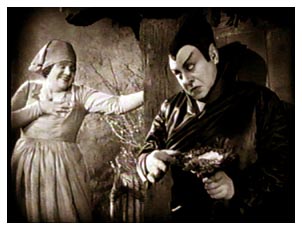 NARRATIVE: Pestilence overshadows a city and
defeats the skill of Dr. Faust. In despair he calls on the Devil
but has to sign his name to a document formally renouncing God,
after which he gets power which avails nothing as the people stone
him when he recoils from a crucifix. The Devil then offers Youth,
and he dons a younger body to accompany Faust on a journey of
pleasure. They visit a famous beauty whose consort Mephistopheles
murders and who is surrendered into Faust's arms while the Devil's
power is shown by an hourglass symbol.
NARRATIVE: Pestilence overshadows a city and
defeats the skill of Dr. Faust. In despair he calls on the Devil
but has to sign his name to a document formally renouncing God,
after which he gets power which avails nothing as the people stone
him when he recoils from a crucifix. The Devil then offers Youth,
and he dons a younger body to accompany Faust on a journey of
pleasure. They visit a famous beauty whose consort Mephistopheles
murders and who is surrendered into Faust's arms while the Devil's
power is shown by an hourglass symbol.
Returning to his own country, Faust sees and at once falls in love with the beautiful and innocent Marguerite. Mephistopheles makes facetious overtures to her aunt and contrives her seduction by Faust and the death of her mother. He then baits her soldier brother who dashes to the house and fights the duel during which Mephistopheles stabs him in the back and then cries "murder" before making a getaway with Faust.
Marguerite, publicly shamed, wanders away, deserted; her baby dies of exposure; she is condemned to be burned at the stake, but she desperately calls on Faust. He, now realizing the Devil's machinations and refuting him, returns to her, aged again but recognized, and they are reunited amid the flames.
EPILOGUE: The angel wins his challenge and accepts Faust because . . . "since, in the depths of his heart this man kept faith, he belongs to God."
Viewed without bias, the narrative is revealed to be fundamentally
banal and worthless. It is, in fact, almost identical with the
old favourite of the movies, that of the philandering young millionaire
who does wrong by the poor little girl but atones in the last
reel owing to his aged mother's death, or to being rescued from
death, etc. The value of the film under discussion will be found,
therefore, not in the narrative but in the asides, the acting,
the directorial construction and the design and photography. The
prologue and epilogue are so banal and crudely obvious that the
above resumé of their content will suffice.
The film proper opens with a distant shot of a small mediaeval
town, over which there fades a black pall, the giant, black-winged
figure of Mephistopheles. Cut to a telling shot of a horror-stricken
woman amid hurrying forms with a dark cross framing the foreground.
Cut back to the Devil's pall spread further over the town. But,
unfortunately, someone has superimposed "PESTILENCE!"
over this, thereby spoiling the realism, as well as the composition
of the picture. The excellently arranged and memorable shot is
a double print of the model town and the winged Emil Jannings
- negative-positive makes this type of effect easy. Then - a fine
example of the correct filmic portrayal of the general by showing
the particular - a girl dashes wildly up the stair to Dr. Faust's
room . . .
(a) L.S. She dashes up the stair . . .
(b) M.S. . . . hammers on his door . . .
(c) L.S. (interior) He opens; she falls at his feet. (Superimposed
title "Doctor, my mother is dying!") MIX TO
(d) CM.S. They are with the sick woman; the girl steals away .
. .
(e) C.S. The woman: Faust's hand pours medicine into her mouth
. . .
(f) CM.S. She clutches him - falls back, dead. He casts down the
phial . . .
(g) C.S. . . it shatters on the floor.
(h) CM.S. He gets to his feet . . .
(i) M.S. . . . and goes to the door, and opens it; the daughter
can be seen through it; she approaches, wild with anxiety, comes
through, looks towards the bed, cries out and . . .
(j) C.S. . . . throws herself down by her mother.
These shots are most beautifully conceived and executed, except (g) wherein focus that is too sharp isolates the shot and over-emphasises what was already obvious. It is an axiom that a change of light tone or of focus sharpness emphasises the shot concerned, but this effect needs careful (and not too frequent) application. Shot (a) shows a fine set with a view of church and other roofs in the background. (b) is reminiscent of Brigitte Helm's frenzied knocking on the door in "Metropolis" in arrangement, but, of course, quite different in direction, lacking (appropriately) the Langish touch.
As the girl bows her head, it comes behind the "dy"
of "dying!" This may be a new Art Form, but it is too
abstruse for the present writer who is also unable to explain
the 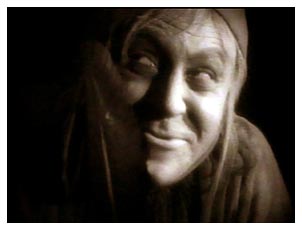 significance
of the exclamation mark with which this and many of the other
dialogue titles are burdened. (e) and (f) are subtly lit with
a hint of the shades of death. (i) is a dramatic use of background
action. And again in (j), light is applied with skill, the face
of the dead woman being gruesomely dark.
significance
of the exclamation mark with which this and many of the other
dialogue titles are burdened. (e) and (f) are subtly lit with
a hint of the shades of death. (i) is a dramatic use of background
action. And again in (j), light is applied with skill, the face
of the dead woman being gruesomely dark.
In despair, Faust burns his learned tomes - but one bursts open and reveals instructions for invoking the Devil.
At a sinister crossroads, with a gnarled tree as grim sentinel and dim mists lit by the full moon (another beautiful studio set), Faust calls upon the Devil. Clouds obscure the moon - a great wind arises. A circle of livid fire surrounds him. In the black sky appears the Devil's chariot. Lightning rends the sky; a ball of fire drops. As the flames die away, there is revealed a queer figure seated on a mound. Faust staggers to his feet. The Devil gravely doffs his skull cap.
Frightened, Faust hurries away, and as the Devil looks round after him, his eyes shine horribly white . . . Among the superb touches in the above sequence are the buffeting wind, the smoking light (remains of the fire ball) serving to back-light the Devil and the horribly shining eye.
The idea "inescapable" is powerfully expressed. (As Faust proceeded home, at every corner the Devil appeared, eyeing him. This sequence has unfortunately been cut). Then we see an empty long shot of a form seated at the table - and, as Faust throws open his door, we see the dreaded form over his shoulder. A close-up reveals the skills of Janning's make-up slightly recalling the aged convict in "Vaudeville," though here the eyes are the Devil's eyes.
Playing on his desire to help the sick, symbolized by a detail shot of suppliant hands, Faust is persuaded to sign the parchment renouncing God using the Devil's black quill - a witty touch. Then he walks out to the sick while the Devil, with a triumphant flourish, rolls up the parchment in mid-shot - which is an individual triumph of superlatively brilliant action by Jannings. Outside, Faust recoils from the crucifix held by a sick man, and the crowd stones him. So, in horror and despair, he returns to his room. The stones bounce absurdly, a ludicrous weakness redeemed by the effective detail of one stone splintering a wooden panel. From an alcove, Faust takes a poison and pours some out. He is stopped by the Devil who causes to appear in the dark liquid his likeness as a young man - and Faust asks for Youth.
The Devil throws a covering over Faust, flames rise from
it, and as they die down, the covering is whipped away to reveal
the youthful Faust in sharp, white profile - an 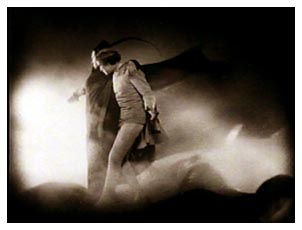 excellent use of the tonal
value of the shot for emphasis. And from the form of the old Devil
steps a youthful, more soigné, shinily blacked robed Mephisto
(as we feel we may now call him with dangerous familiarity, so
the direction subtly conveys). Mephisto waves away his old body
which moodily disappears - an extremely effective but simple double
exposure. Then, in another double-exposure which is actually a
split-screen shot, Mephisto conjures up the form of a woman, again
used symbolically.
excellent use of the tonal
value of the shot for emphasis. And from the form of the old Devil
steps a youthful, more soigné, shinily blacked robed Mephisto
(as we feel we may now call him with dangerous familiarity, so
the direction subtly conveys). Mephisto waves away his old body
which moodily disappears - an extremely effective but simple double
exposure. Then, in another double-exposure which is actually a
split-screen shot, Mephisto conjures up the form of a woman, again
used symbolically.
To go out in search of further wonders, Mephisto spreads his mantle, and they stand on it. A great wind shatters the window, and in a long shot they proceed out and up into the sky. This effect is a simple double exposure of the empty room with dark area for the window and backward tracking shot of the two on the mantle against a dead black background (and in the teeth of the wind machine). Their exhilarating journey is excellently shown, shots "from the air" of superb models and weird birds being inter-cut with mid and close-shots of themselves - wind and vapour stirring them.
The rather clumsy Duchess of Parma sequence follows with its huge set, decorated elephants, spectacular diamond, vicious murder by Mephisto of the consort, and reminder to Faust, by means of the hourglass symbol and the recalled vision of age, that his youth is only on contract. An excellent touch is the immediate disappearance from Mephisto's hand of the hourglass when Faust begs, yielding to temptation, "Leave me Youth!" This is simply done by stopping and restarting the camera, the actors keeping dead still during the removal of the hourglass. A hardly perceptible jerk occurs in this case.
Much of the relevant detail at this part of the film occurs at the very top of the frame, and it is unfortunate that a part of the picture area has been lost in the reduction prints. Thus, in the shot referred to, only the lower half of the hourglass is seen, which will result in the effect being unnoticed by the less observant. Other losses are part of the Devil's chariot and half of Janning's head after the murder of the consort.
Against a back-projected background mixed to suit - and most effectively composed - Faust demands a return to his own country where they duly appear in a beautifully designed exterior set, mingling with a well-selected crowd, and discover it is Easter - a good example of choice of special environment to suit the action.
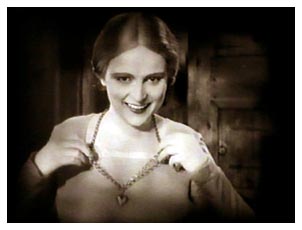 His recollections of childhood
delight Faust. Then one girl passes along. Mephisto makes a move
that causes her to drop her flowers - marguerites - which Faust
picks up. The girl proceeds. Mephisto warns Faust from her, a
ruse to increase his passion. He walks to the door of the church,
and in close-up with shining eyes, looks at Marguerite standing
at the back, a shaft of sunlight streaming across the church interior.
The Blessing causes Mephisto to recoil and hide his face - and
Faust also knows fear.
His recollections of childhood
delight Faust. Then one girl passes along. Mephisto makes a move
that causes her to drop her flowers - marguerites - which Faust
picks up. The girl proceeds. Mephisto warns Faust from her, a
ruse to increase his passion. He walks to the door of the church,
and in close-up with shining eyes, looks at Marguerite standing
at the back, a shaft of sunlight streaming across the church interior.
The Blessing causes Mephisto to recoil and hide his face - and
Faust also knows fear.
A really excellent pictorial composition introduces Marguerite and her mother at home - sunlight beams through the window. The mother's chair is subtly emphasised in a way that adds power to a certain shot much later in the film, proving once again the need for pre-shooting planning by director - scenarist - cameraman - designer (design of suitable chair, or alternatively choice thereof, if a specific period). In this case a low angle is employed which allows a diagonal composition to be maintained throughout the action of the shot.
Marguerite's soldier brother returns from war, gives her a shawl, teases her - while Mephisto enters her room and leaves a necklace on her dressing table. When Marguerite enters the room she is conscious of a queer evil in the atmosphere and flings wide the window - only to see Faust, as arranged by Mephisto. She shuts the window and, thrilled, espies the "present." It will be noticed how logically the cause-and-effect in the scenario is contrived. The suggestion of an evil presence having been in the room is admirably put over by Camilla Horn's acting, assisted by mood lighting in the themed-shot concerned.
Marguerite shows the necklace to her comic Aunt Martha but runs off at her suggestion that it's a sweetheart's gift to join a group of children at play. Then, in a self-consciously composed shot seen through a patterned foreground of willow, Mephisto leads Faust to see them.
Aunt Martha is having a quiet drink when Mephisto butts
in and, after a piece of polished gesturing, hands her a gift.
The sublime drinking scene has unfortunately been cut. Even so,
it is made clear that Aunt Martha has supped with the Devil .
. . meanwhile Faust joins in the children's game, catches Marguerite
and kisses her. The end of resistance to him is clearly expressed
in one brilliant close-up. Another love scene follows in another
garden nook, and Faust puts a ring on her finger.
That evening Marguerite is in her candle-lit bedroom, ready
for bed. Mephisto urges Faust in . . . "I'll keep her brother
away . . ."
Then . . .
(a) M.S. Marguerite opens her window, leans back inhaling the
air; then Faust appears in the opening; she sees him, slams the
window . . .
(b) CM.S. (exterior) He puts his hands on the leaded panes, pushes.
They open slightly, and the disturbed girl can been seen. She
slams the windows again . . .
(c) M.S. . . . but he presses them open again, and she retreats,
leans against the wall, head bent.
The impact of these three shots is amazing, and their meaning concisely and implicitly conveyed. The lighting is perfect, as will be seen from the stills of each reproduced herewith.
Meanwhile, in a superb tavern set consisting mainly of two huge barrels and a curved ceiling with a door high in one corner, Mephisto baits the brother with a toast "To Marguerite - and her lover!" He then blinds the company with a flash of fire to cover his getaway, after which the brother dashes out, brandishing his sword. (The substitution of "Margaret" for "Marguerite" throughout this version of the film dismays the present writer, although it can be supported academically).
Mephisto invokes a great wind, and the mother gets out of
bed. She staggers across the passage to Marguerite's room and,
after a struggle, opens the door which swings back at her - but
she stands looking in horror into the room. . .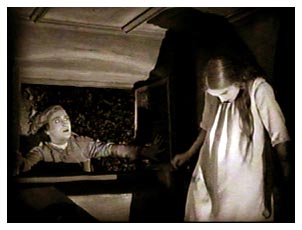
(a) C.S. Marguerite in shame covers her face with the bedclothes
. . .
(b) M.S. Her mother staggers back, collapses, her head striking
the wall of her passage, and lies still. Marguerite runs to her.
FADE OUT
Again, we have been shown two shots of amazing directorial power and narrative conciseness - the close-up in harsh focus, with Faust dimly, immediately above - and the mid-shot of tragic content with a forceful diagonal composition.
The duel is fought in the circle of one spotlight, and Mephisto brutally kills the brother, snapping his sword. Their shadows on the pale house wall are used to add to the patterned composition of the acting. Then Mephisto shouts "Murder!" over the housetops in several picturesque shots over the roofs. People are soon up and about with lamps. Faust, dazed, is dragged away as they arrive at the scene of the crime.
Through swirling smoke, the Requiem Service is shown in
somber long shot. The choir chants piously. Outside the church
door, Marguerite sobs bitterly. Then out flies the line of mourners,
including Aunt Martha, enjoying a few 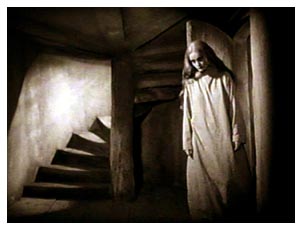 pious
tears. Marguerite approaches her, but is repulsed with a firm
hand . . . for she is Guilty, and Aunt Martha is a Good Woman
(though she has supped with the Devil . . .). In one last tragic
long shot of the still, empty church, Marguerite (in the foreground)
totters and collapses.
pious
tears. Marguerite approaches her, but is repulsed with a firm
hand . . . for she is Guilty, and Aunt Martha is a Good Woman
(though she has supped with the Devil . . .). In one last tragic
long shot of the still, empty church, Marguerite (in the foreground)
totters and collapses.
On release from the stocks, after expiation in face of a jeering crowd (more excellent types), Marguerite goes home to an empty house . . . she stands and looks at her mother's chair, imagines her mother returned (indicated by double-exposure), and collapses sobbing - the last shot recalling the shot referred to at the mother's introduction.
The action then moves on nine months from Easter to Christmas, and after a picturesque long shot with falling snow, we are treated to the banal and sickly touch of mixing from a shot of carol singers to a shot of Marguerite with baby in a roofless shed. Superimposed titles shriek a redundant explanatio,n of what had better been left unsaid.
Bearing "her precious burden" and proceeding "we known not whither," Marguerite staggers across a snowy waste and collapses by a broken fence. Her overwrought mind pictures a little cot with candles (superimposed) into which she places the babe. Then a party of men finds her and the dead child and arrests her. The sentimentality of these scenes defeats their admirable cinematic technique and reveals the one weakness of F.W. Murnau.
Marguerite's despairing cry to Faust is conveyed pictorially by close-ups superimposed on vague, misty tracking shots mixing to a long shot of Faust in the distant country. He gets the message and bitterly curses Mephisto.
Marguerite, in her prison cell, thinks back to the romantic garden, shown by a dissolve based on similarity of form but contrasted environment - and again collapses. Abbreviations in this version serve to make her three collapses coming within a space of about eight minutes on the screen rather ludicrous.
Mephisto, who had held the aged Faust in a mirror, now again produces this and robs him of Youth. Transported to the scene of Marguerite's execution, he forces his way past the guards and ascends the pyre to be by her side. Close-ups of his youthful face and aged face, dissolved, reveal him to her, and a smile transfigures her. Hazily, through the rising flames, they kiss - he young again - and the shot dissolves into a cloudy sky and into the epilogue.
F.W. Murnau's direction is artistic - considered profound. His handling of the film up to the Parma incident seldom wavers from unobtrusive perfection. The moulding together of the acting, narrative, camera, and design phases is remarkable. Later this unity breaks down, the scenario being chiefly at fault. And unfortunately, Murnau suffered from a leaning towards sentimentality which this scenario fostered. This is noticeable in incident (ghostly mother and cradle) and in detail (too many sunbeams in church, too many flowers in garden) and occasionally in atmosphere (the child born at Noel).
There are also occasional technical lapses, such as incorrect camera angles at the final scene when the youthful image of Faust should have been seen subjectively, i.e., through Marguerite's eyes. On the other hand, there are cases of absolute technical perfection, such as the window scene in the bedroom.
Another scenario weakness lies in the disposal of the characters' appearance. Thus, Marguerite only appears about halfway through, and both Mephisto and Faust practically disappear in the last reel - though this has been aggravated in the abbreviated version available. This fact also puts excessive demands on the personality and acting of Camilla Horn who had to take over a screen that had been held by the supreme artistry of Jannings. Further, she had to portray dreary misery, as opposed to the double-edged Devil.
Murnau as director has brought out the best facets of the Jannings' acting - and must also probably be credited with the three good recurring basic effects which assist in welding the film together, namely - the wind motif (crossroads . . . journey on mantle . . . seduction . . . snow scene), the smoke and fire motif (Faust's room . . . crossroads . . . Youth . . . Parma . . . tavern . . . second church scene . . . final scene - also prologue and epilogue), and the unifying elements of the Devil's trickery, both straight-forward (drawer opens itself) and symbolic (aged Faust preserved in mirror).
In Murnau's next film, "Sunrise," in spite of the assistance of the famous scenarist Carl Mayer (who did "Caligari," "The Last Laugh," and "Tartuffe"), hokum sentimentality won the day. It was tragic that one weakness should have caused a really great director to deviate from what might have been a unique advancement in technique.
The photography of Carl Hoffmann is of unique compositional purity and never fails to portray the mood of the sequence. "Faust has memorable moments - the storm-swept, accursed crossroads; Jannings magnificently rolling up the parchment; Aunt Martha, coyly deprecating; Marguerite's little room; the wind - the hourglass - the Devil's eye; and the stricken town. These - with the inimitable stamp of Murnau, Jannings, and Hoffmann - ensure its place in the archives of Cinema.